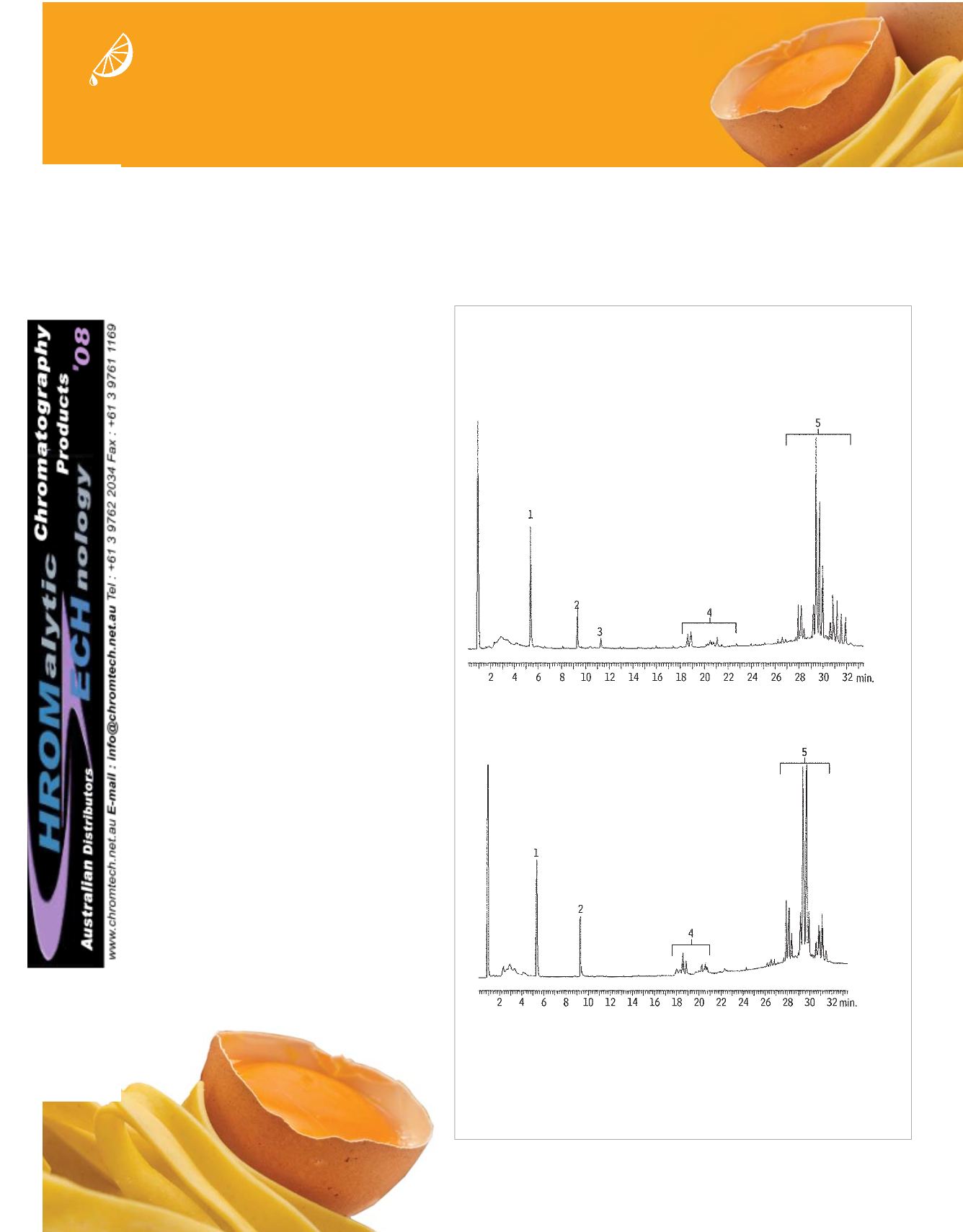

• 14 •
Food, Flavors & Fragrances
Eggs enhance the nutritional and commercial
value of pasta, and thus many countries have
established minimum egg content levels (based on
either counts or weights) for pasta and other egg-
containing products. Although egg content stan-
dards have been established, methods are not usu-
ally specified and a number of procedures may be
applied. Cholesterol methods are often used to
authenticate products claimed on the label to be
made with eggs; however, since cholesterol can be
added using non-egg sources, its presence alone is
not a reliable marker of egg content. Also, even if
egg is the source of the cholesterol in the product,
it is difficult to correlate quantitatively to egg con-
tent levels, because the levels of cholesterol found
naturally in eggs are highly variable. The method
presented here allows the use of glycerides, in addi-
tion to cholesterol, to assess egg content in pasta.
This method provides chromatographic separation
of cholesterol, diglycerides, and triglycerides,
allowing fraudulent (non-egg) sources of choles-
terol to be easily and accurately determined, so qual-
itative and quantitative comparisons can be made.
Simple Extraction Method
Current methods used for the extraction of fat
from flour components generally involve either a
24-hour diethyl ether extraction or an 8-hour
Soxhlet extraction. The extraction described here
is rapid by comparison. In this simple procedure,
fat is extracted from egg pasta dough and freeze-
dried egg product by homogenizing the samples
and pouring them into glass columns filled with
sodium sulfate. The fat phase is eluted with 100mL
diethyl ether and then evaporated with nitrogen.
Approximately 50mg of the dried fat extract is
then dissolved in 1mL internal standard solution
(3,000 ppm squalene in diethyl ether). The extract-
ed samples are analyzed by gas chromatography
(GC) using an Rtx®-65TG column, which is
specifically tested for triglyceride performance.
Figure 1
Easily detect fraud by comparing cholesterol and
glyceride profiles in one run on the Rtx®-65TG column.
Prevent Fraud in Egg Pasta with Simple
Analysis of Cholesterol and Glycerides
Eliminate the uncertainty of using cholesterol alone to authenticate egg content. Determine both
glycerides and cholesterol in a single run using an
Rtx®-65TG
column and get definitive, fraud-
identifying results.
By Julie Kowalski, Ph.D., Food Flavors, and Fragrances Innovations Chemist, Gary Stidsen, Product Marketing Manager, Daniele Naviglio*, Professor, Analytical
Chemist, and Fabiana Pizzolongo*, Ph.D., Food Technologist
*Dipartimento di Scienza degli Alimenti – Università degli Studi di Napoli “Federico II” – Via Università, 100 - 80055 Portici (NA) – Italia
GC_FF01046
1. squalene (IS)
2. cholesterol
3.
β
-sitosterol
4. diglycerides
5. triglycerids
Column:
Rtx
®
-65TG, 30m, 0.25mm ID, 0.10µm (cat.# 17008)
Sample:
A. 50µg/mL fat extract from egg pasta in diethyl ether solution with 3,000ppm squalene (IS)
B. 50µg/mL fat extract from egg in diethyl ether solution with 3,000ppm squalene (IS)
Inj.:
0.5µL, split (1:80), 70°C (hold 12 sec.) at 99°C up to 370°C (hold 5 min.)
Carrier gas: hydrogen
Flow rate:
1.5mL/min.
Oven temp.: 220°C (hold 2.0 min.) to 360°C @ 5°C/min. (hold 5 min.)
Det:
FID @ 370°C
GC_FF01045
A. Extracted egg pasta fats
B. Extracted egg fats
More acurate than
cholesterol-only
methods!
800-356-1688 •
www.restek.com










